This Post May Contain Affiliate Links. Please Read Our Disclosure Policy.
This vibrant, tangy chimichurri sauce is not only the easiest chimichurri recipe to make, it’s also the best I’ve ever tasted! A perfect copycat for Texas de Brazil’s own chimichurri, it’s full of fresh herbs, rich oil, bold garlic, and perfectly balanced spices. I have a jar of this chimichurri in my fridge at all times to use as a marinade or sauce for steaks, chicken, shrimp, fish, or pork.

🌿 What is Chimichurri?
Chimichurri is a savory, herbaceous sauce that originated in Argentina and Uruguay, though today its popularity extends far beyond Latin America. There’s no cooking involved in making chimichurri, as it’s commonly used as a marinade or a condiment for various meats or sides.
The ingredients list for classic green chimichurri is simple: garlic, olive oil, parsley, vinegar, oregano, red pepper flakes, and salt.
Because this version is a copycat of Texas de Brazil’s chimichurri, the recipe differs a little from traditional chimichurri due to the addition of cilantro. You’re welcome to replace the cilantro with additional parsley for a more authentic sauce! It also uses lemon juice for acidity instead of red wine vinegar. I personally prefer the flavor of the lemon juice with the rest of the ingredients, but you can swap it out easily.
🧄 What Makes This Recipe So Good
- When I tell you I’m obsessed with this sauce, I mean I am OB. SESSED. WITH. THIS. SAUCE! I’ve been making it for a solid decade now, and it’s such a staple in my meal plan that to this day it has its own spot in my fridge. I always have a batch on hand. The flavors are incredible, and it’s so unbelievably versatile. I’ve used it on basically everything at this point – seared ribeye, chimichurri rice, garlic mashed potatoes, fried eggs, even a dip for pizza! I’ve never once been disappointed.
- This chimichurri recipe is a perfect copycat for the chimichurri served at Texas de Brazil, and making it could NOT be easier. Basically all you have to do is add everything to the food processor and process until you’ve got a well-mixed sauce. I like to add the ingredients incrementally to be sure everything’s finely chopped and you don’t get any giant pieces of garlic or herb leaves in a bite.
- Since this chimichurri recipe really only uses oil, herbs, and spices, it’s naturally paleo, Whole30, keto, low carb, vegetarian, vegan, dairy free, and gluten free. I know it’s hard to believe something this good works for so many different dietary needs, but… believe it! It’s true!
👩🏼🍳 Chef’s Tips
- One of the really great things about this chimichurri recipe is that it’s totally customizable. You can adjust the amounts of each ingredient until you’ve got your perfect sauce. Maybe you want less oil and more herbs. Go for it! Scale back the garlic if you’re not big on that raw flavor. Replace the cilantro with more parsley for a more authentic chimichurri. Use red wine vinegar instead of lemon juice. Anything goes!
- When it comes to salt, I always recommend starting out low. I like my chimichurri salty, so I actually use a full tablespoon in my own batches. I’ve written the recipe with just ½ tablespoon, though, because you can always add more, but you can’t take it back out. It’s way better (and less frustrating) to under-salt it than to over-salt it.
- If you don’t have a food processor, you can actually make this whole chimichurri recipe by hand instead! It takes a little more effort and a little more time, but you still end up with a delicious chimichurri in the end. Use a sharp knife to mince the garlic, parsley, and cilantro really well. From there, add everything to a bowl and whisk vigorously until all the ingredients are fully incorporated.
- It’s super important that you use a high-quality, great-tasting olive oil (or EVOO) to make your chimichurri. Since the olive oil is so prominent, using a subpar oil can absolutely wreck the flavor of the sauce. Low-quality olive oils will taste oily and bitter, and some are even diluted with older batches of olive oil or other oils altogether. High-quality oils have a more subtle, herby, sometimes fruity taste and aroma. Your oil needs to be fresh, too. Even high-quality olive oil will taste rancid after it expires.
💡 Chimichurri Variations
- Light Chimichurri: Instead of 1 cup olive oil, use ⅓ cup water and ⅔ cup olive oil. For an even lighter chimichurri, use ½ cup water and ½ cup olive oil.
- Avocado Chimichurri: Instead of 1 cup olive oil, use only ½ cup olive oil and add the flesh of one large avocado.
- Mild Chimichurri: Reduce the amount of crushed red pepper flakes or omit them entirely.
💬 Frequently Asked Questions
No! They’re both herb sauces that use garlic and olive oil, but that’s pretty much where the ingredient similarities end. Pesto is typically made with basil, pine nuts, parmesan, and pecorino. You won’t find any of those ingredients in a chimichurri.
If your parsley was picked too late in the season, it can have a bitter flavor, which would affect the taste of the chimichurri. Older olive oil and low-quality olive oil can also make the sauce bitter, as can using too much garlic.
Nope! At least, I don’t consider it spicy. This recipe does include red pepper flakes, so if you’re heat-sensitive, you may want to reduce or eliminate that ingredient.
Traditionally, chimichurri is a mixture of garlic, olive oil, parsley, red wine vinegar, oregano, crushed red pepper, and salt.
Sometimes! Authentic recipes generally only use parsley – no cilantro at all. This recipe is a copycat for Texas de Brazil’s chimichurri which does use cilantro.
Pretty much anything! It’s perfect as a marinade or topping for grilled or roasted meats like steak, chicken, shrimp, scallops, pork chops, fish, etc. You can also drizzle chimichurri over roasted vegetables, baked or mashed potatoes, fried eggs, cooked rice, salads, and pasta.

🥘 Try These Recipes While You’re Here!
- Cream Cheese Garlic Skillet Chicken
- Keto Eggplant Parmesan
- Garlic Bread Casserole
- Chicken Stroganoff
- How to Cook Nopales (Cactus Paddles)
- Sous Vide Pork Belly
- Carnitas Burritos
- Sauteed Shrimp in Garlic Butter Sauce
- Grilled Mango with Chili-Lime Salt
- Chickarina Soup
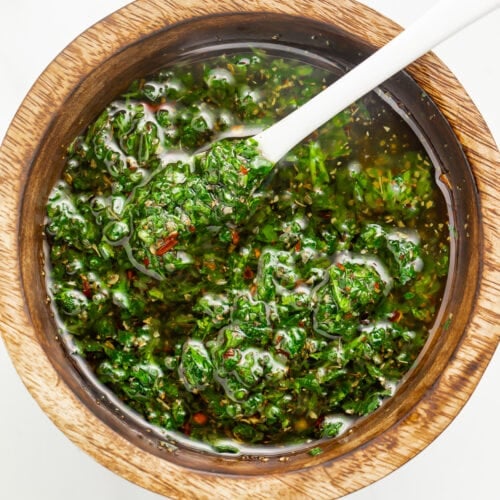
Best Ever Chimichurri Recipe (from Texas de Brazil)
Equipment
- Food processor see Notes
- Silicone spatula
- Airtight container
Ingredients
- 2 tablespoons roughly chopped fresh garlic approximately 6 cloves, more or less to taste
- ½ cup fresh parsley leaves
- ¼ cup fresh cilantro leaves
- 1 cup high-quality olive oil or avocado oil
- ¼ cup fresh lemon juice 4 tablespoons, from approximately 2 large lemons
- 1 tablespoon dried oregano
- 1 tablespoon crushed red pepper more or less to taste
- ½ tablespoon table salt plus more to taste
Instructions
- Add 2 tablespoons roughly chopped fresh garlic to bowl of food processor. Pulse garlic until minced.
- Add ½ cup fresh parsley leaves and ¼ cup fresh cilantro leaves to food processor with minced garlic. Pulse until leaves are uniformly chopped. Scrape down sides of food processor bowl with silicone spatula as needed.
- Add 1 cup high-quality olive oil, ¼ cup fresh lemon juice, 1 tablespoon dried oregano, 1 tablespoon crushed red pepper (to taste), and ½ tablespoon table salt (to taste) to food processor. Pulse until ingredients are well combined, being careful not to over-process mixture into paste. Scrape down sides of food processor bowl with silicone spatula as needed.
- Taste chimichurri and add garlic, crushed red pepper, and salt as needed. Add ingredients in small increments and pulse 1 to 2 times to incorporate. Taste again and continue adjusting if needed.
- When satisfied with flavor, use prepared chimichurri to marinate meat of choice, or transfer sauce to airtight container and refrigerate until ready to use.
Video
- Food Processor: If you don’t have a food processor, mince the garlic, parsley, and cilantro with a sharp knife, then add all ingredients to a mixing bowl. Whisk vigorously until the ingredients are well incorporated.
- Oil: Use a high-quality olive oil or EVOO, and make sure it’s fresh. Low quality oils will taste bitter and oily, and older oils will taste rancid. You can also replace the olive oil with avocado oil, but that will give the sauce a slightly different flavor.
- Cilantro: This is a copycat recipe for Texas de Brazil’s chimichurri sauce, which uses cilantro as the primary herb. Traditional Argentinian chimichurri typically uses parsley only. Feel free to replace the ¼ cup of cilantro leaves with an additional ¼ cup of parsley leaves if you’d prefer.
- Crushed Red Pepper: If you’re heat-sensitive, start with only ¼ or ½ tablespoon of red pepper flakes. I don’t consider this recipe very spicy as-written, but you might!
- Salt: I generally use 1 tablespoon of salt in my chimichurri, but I recommend starting with only ½ tablespoon, then adding more if needed.
- Consistency: This is intended to be a thin, liquidy, oily sauce. Check out the video below to get an idea of the target consistency. Be careful not to over-mix the ingredients or you’ll end up with more of a paste.
- Storage: Keep the chimichurri sauce refrigerated in an airtight container. It’ll keep approximately 2 weeks if stored properly. If any separation occurs, shake container or whisk sauce vigorously until ingredients are reincorporated.
Approximate Information for One Serving
Nutrition Disclaimers
Number of total servings shown is approximate. Actual number of servings will depend on your preferred portion sizes.
Nutritional values shown are general guidelines and reflect information for 1 serving using the ingredients listed, not including any optional ingredients. Actual macros may vary slightly depending on specific brands and types of ingredients used.
To determine the weight of one serving, prepare the recipe as instructed. Weigh the finished recipe, then divide the weight of the finished recipe (not including the weight of the container the food is in) by the desired number of servings. Result will be the weight of one serving.
Did You Make This Recipe?
Tag @40aprons on Instagram and be sure to leave a review on the blog post!
Never Miss A Meal!
New Recipes Straight To Your Inbox
A curated selection of our most recent recipes, delivered straight to your inbox once a week.
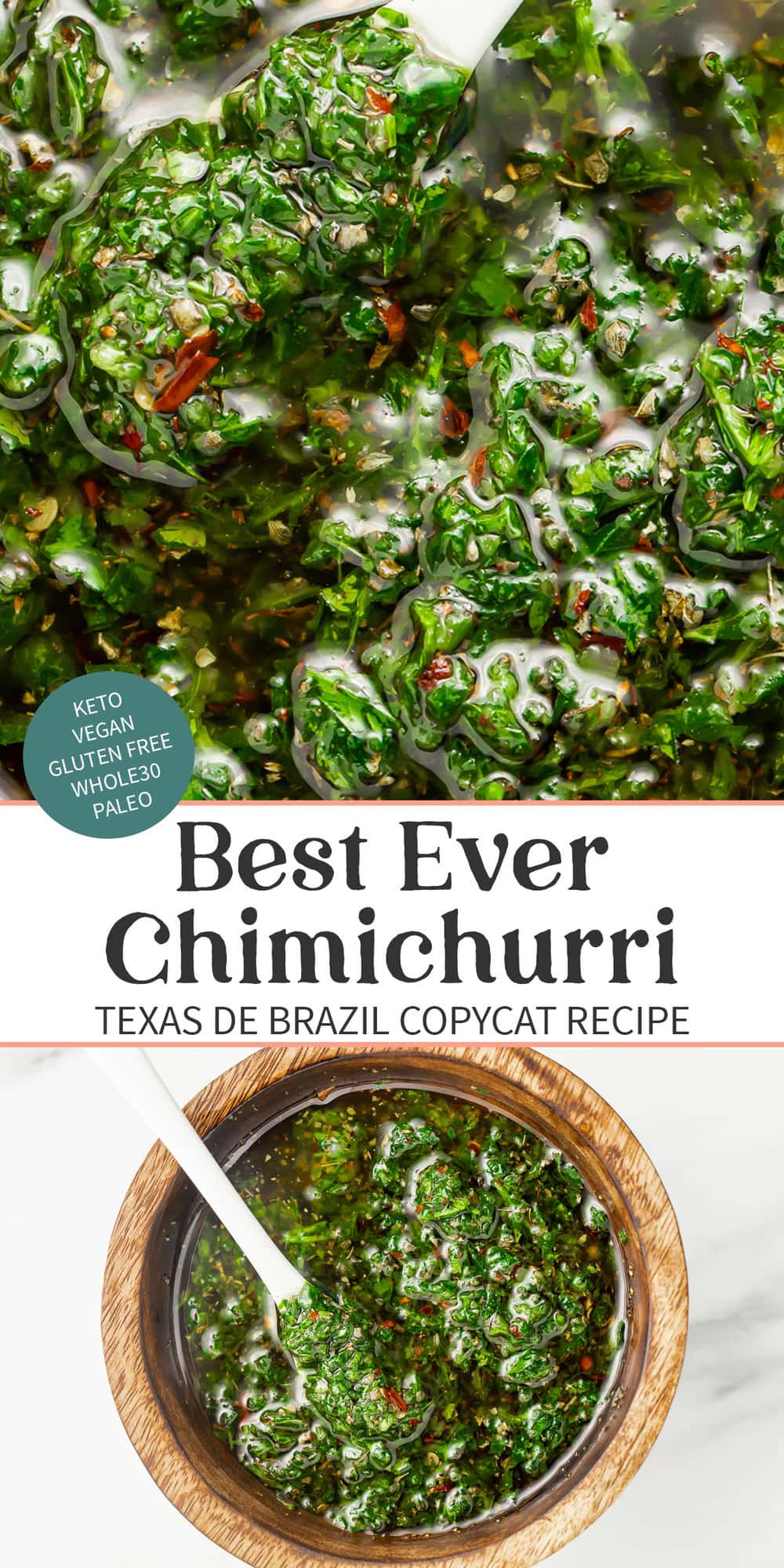


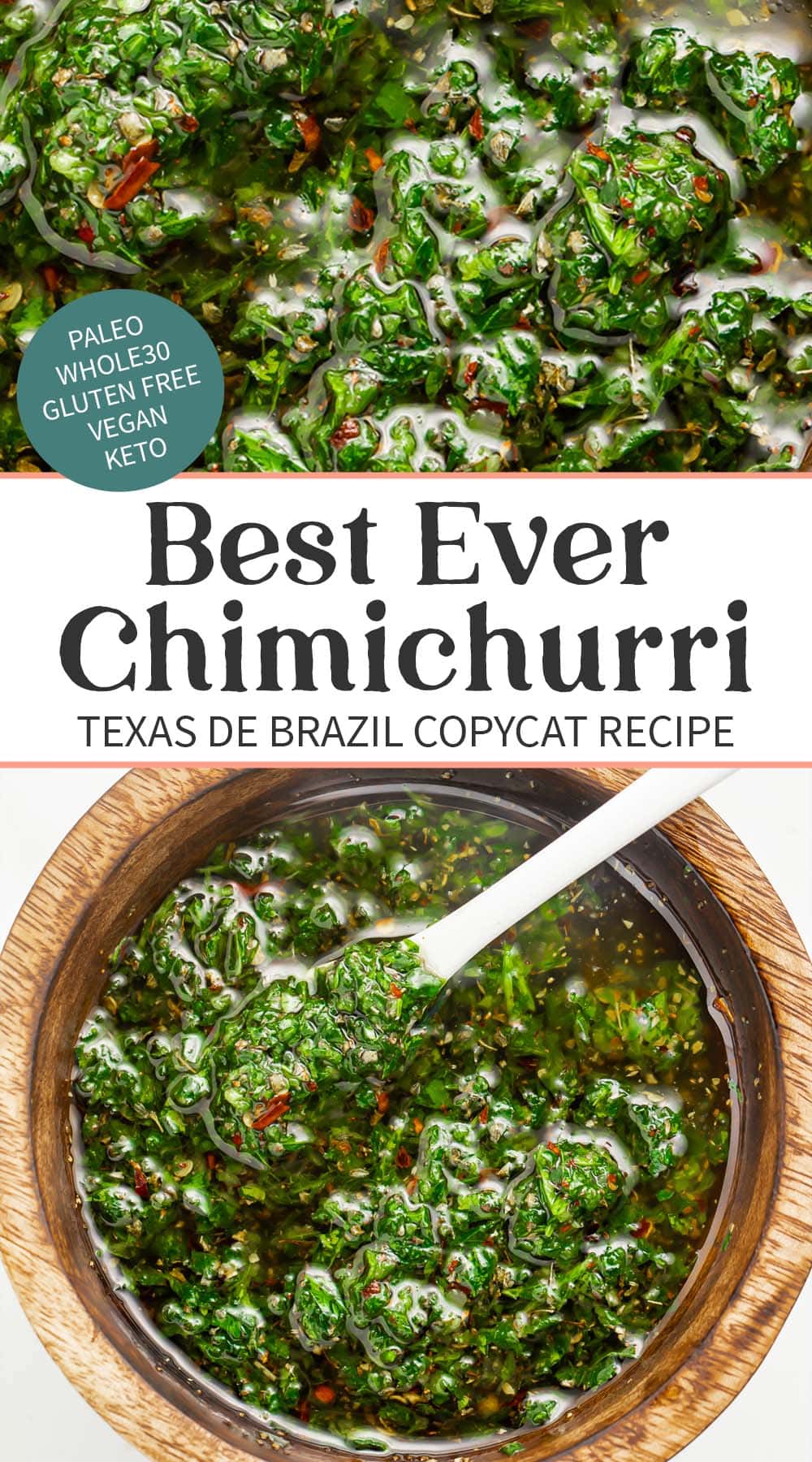
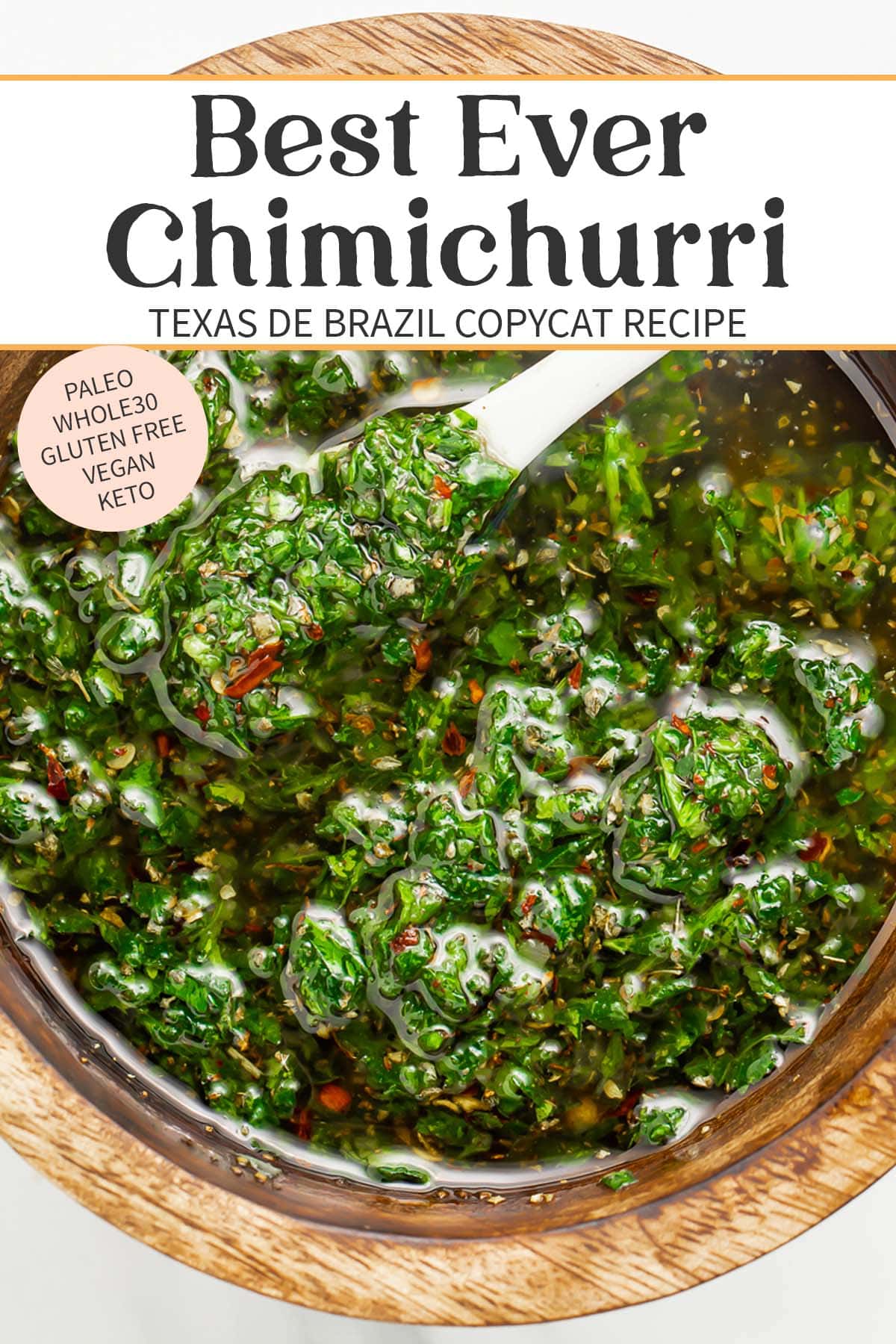
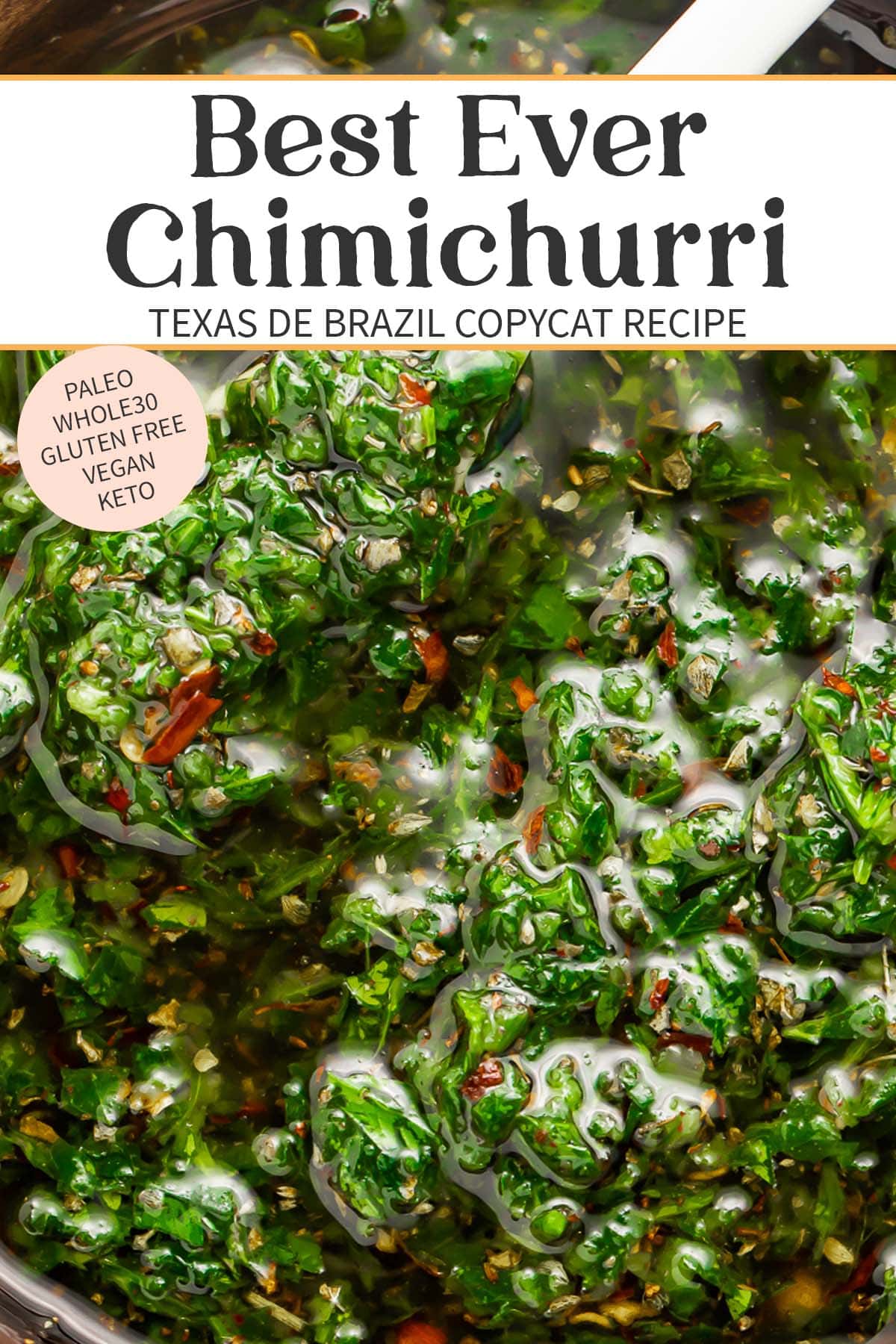
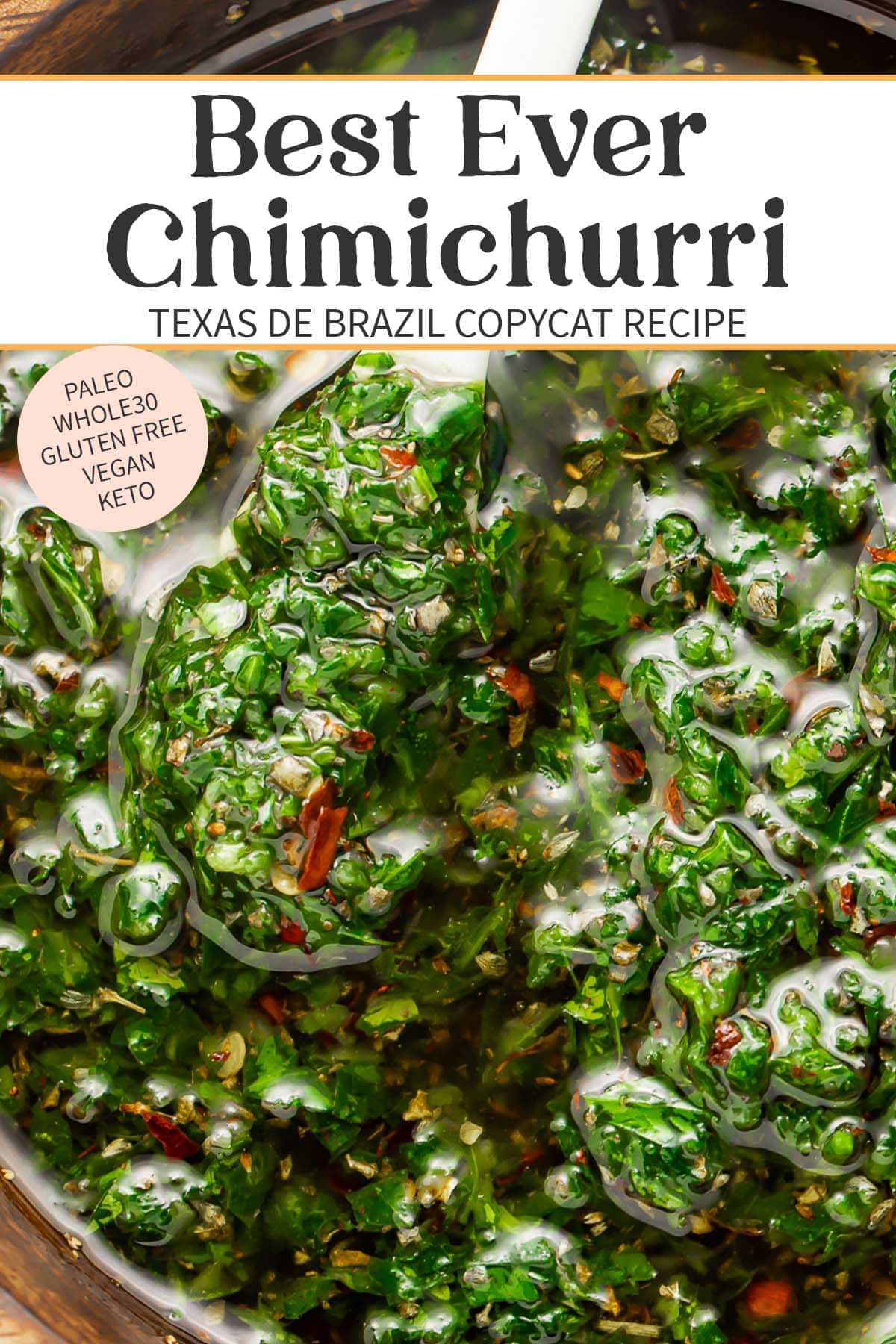

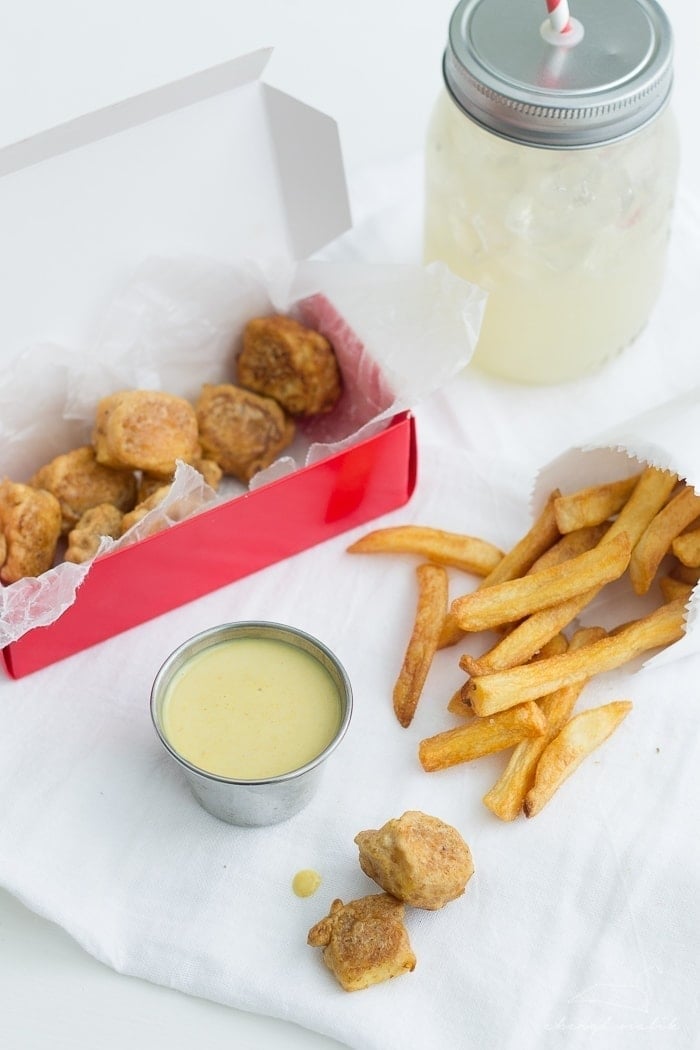
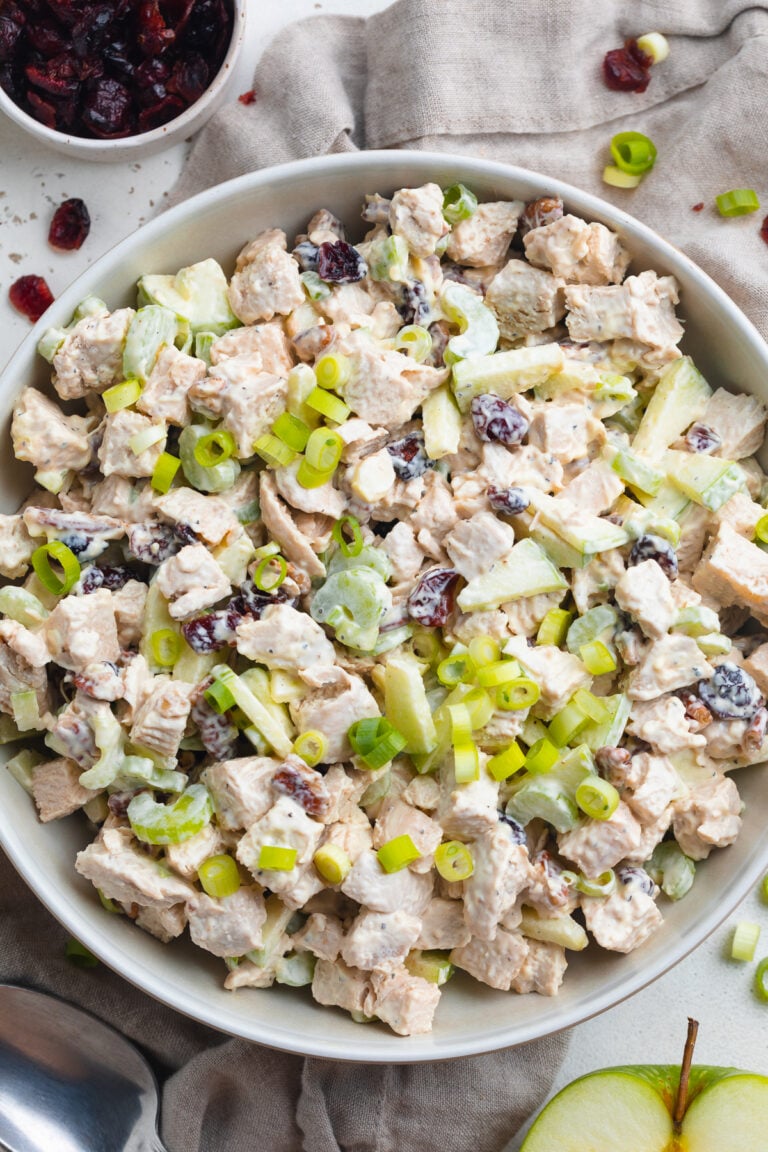
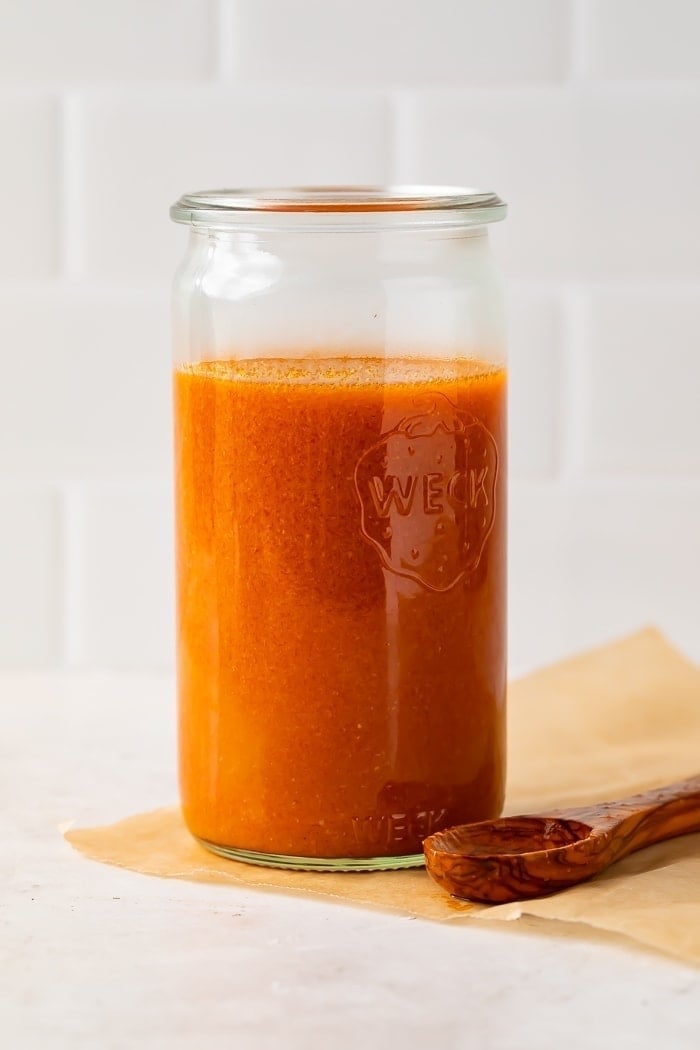
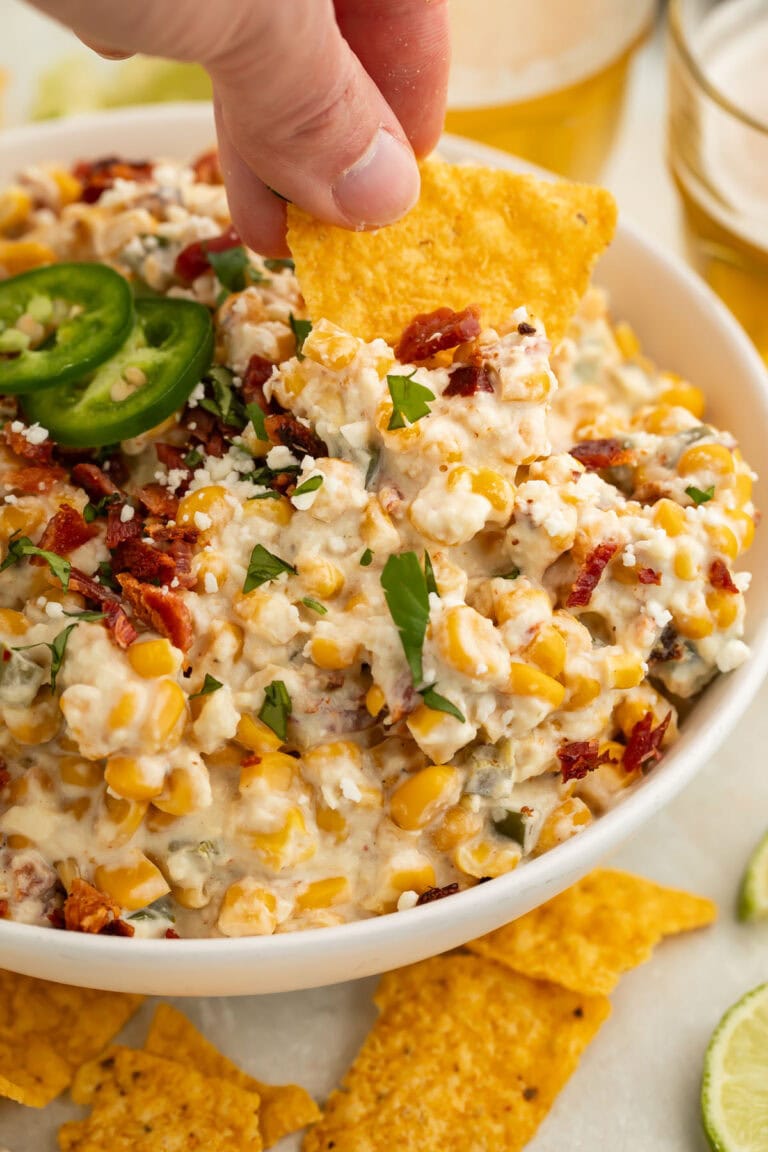
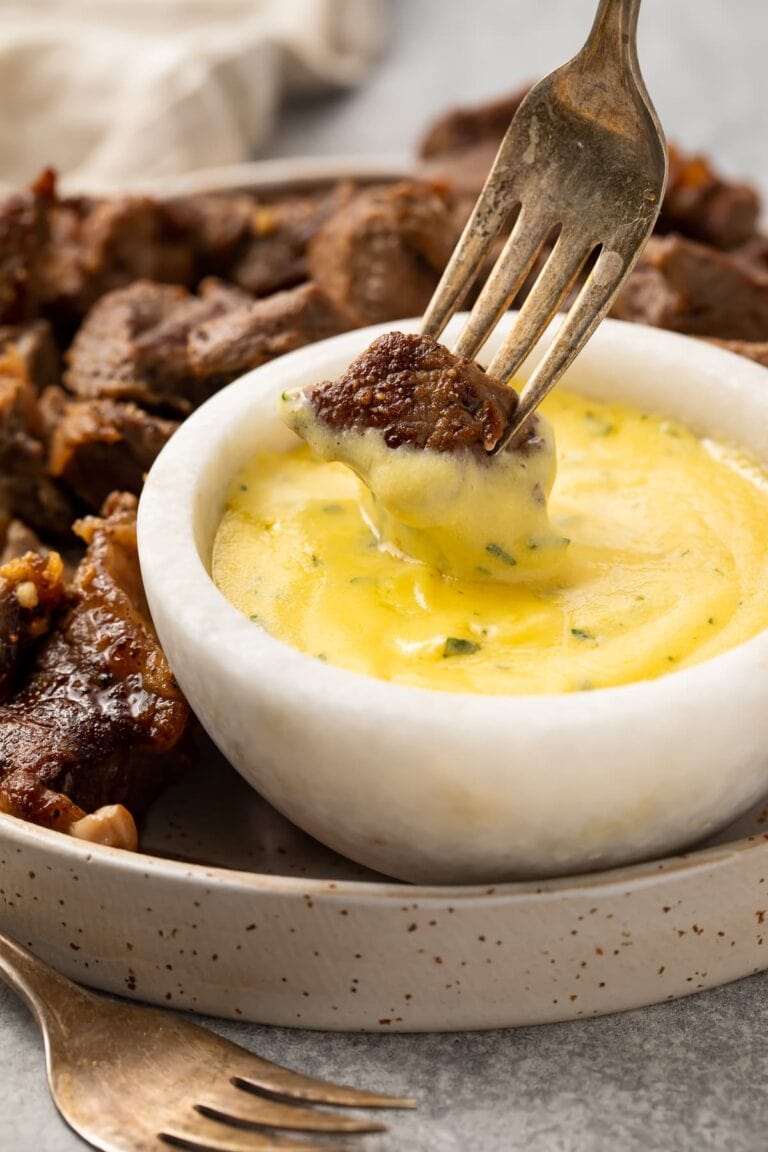










Soy Argentina y que yo sepa, el chimichurri no lleva cilantro, dejen de inventar viven cambiando las recetas y despues se quejan porque no les salen bien.
Hi, Maria! As we mention in the post, this is not intended to be a classic or authentic chimichurri – which, you’re completely right, typically doesn’t include cilantro. This is a copycat recipe of the specific chimichurri served at Texas de Brazil.
your instructions are a bit confusing. Step 1: mince garlic, then Step 2: put in parsley and cilantro with minced garlic, then Step 4: taste Chimichurri and add garlic as needed? The garlic is still in there with the parsley and cilantro right?
Hi, Bonnie! That’s where the “more or less to taste” comes in to play. If you taste the chimichurri and decide it needs more garlic, you can add garlic as needed to get the flavor just how you want it. Same with the crushed red pepper and salt. 🙂 I hope that helps!
I love this recipe and I constantly get compliments and requests for the recipe. It compliments many meats and fish and I always keep a container around.
We’re so glad it’s a favorite! Thanks so much for sharing, Katie! 😊
When i found this recipe many years ago i simply quit looking for other chimichurri recipes. Its that good. this has absolutely everything i like in it. However the only thing i do differently is cut the salt by half. Id suggest starting here and then adding more if you desire. Please note its supposed to be salty. Yet, half works best for our palates.
This recipe literally blows the doors off everything else ive tried over the decades. The cilantro adds the magic. go crazy with the herbs here. thats what this is all about. Thanks for an absolutely EPIC recipe!
Thank you so much for the wonderful review, Joe! We’re so glad you love the recipe so much! 😊
This recipe is wonderful!!
I was wondering it I could make it and freeze it or has anyone waterbath canned it?
Thank you
We haven’t tried canning or freezing it, so we can’t say for sure. Be sure to let us know if you try it! 😊
Followed the recipe as written except I halved the amount of olive oil (1/2 cup used instead of 1 full cup), and I added a fresh cayenne pepper out of the garden instead of crushed red pepper. It is fantastic! Iam cooking a Tri-Tip tomorrow and will be using this chimichurri as a condiment to serve with it. Thank you!
Ooh, that sounds delicious! Thanks for sharing! 😊
I love this chimichurri recipe! However I highly recommend cutting way back on the olive oil, start with 1/3 cup and process and add more if needed, I think I used maybe 1/2 cup. Otherwise this recipe is perfect!
So glad you love it! Thanks for sharing, Elizabeth!
Thanks for the suggestion on the oil. I followed your lead and it turned out amazing!
Very yummy! Great for everything!
I agree!! So glad you loved it! 😊
Great recipe but, l kicked it up with a teaspoon of cumin. Put it on grilled shrimp.
Cumin sounds like a delicious addition to this! So glad you enjoyed it, John. 😊
Have made this too many times to count and I just made a quadruple batch.
So glad it’s been a favorite! Thanks for sharing, Hara!